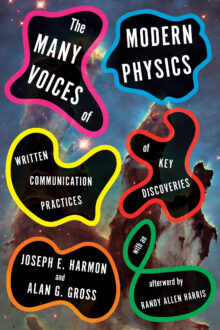

Joseph E. Harmon
Joseph E. Harmon has been a science writer, editor, and manager for four decades in several divisions within Argonne National Laboratory. He is now working as a science communicator in support of Argonne’s Physical Sciences and Engineering Directorate. As an independent scholar, he has coauthored five other scholarly books with Alan G. Gross. Harmon and Gross won Best Book in Technical or Scientific Communication from the National Council of Teachers of English for The Scientific Literature: A Guided Tour.
The Many Voices of Modern Physics
Written Communication Practices of Key Discoveries
The Many Voices of Modern Physics follows a revolution that began in 1905 when Albert Einstein published papers on special relativity and quantum theory. Unlike Newtonian physics, this new physics often departs wildly from common sense, a radical divorce that presents a unique communicative challenge to physicists when writing for other physicists or for the general public, and to journalists and popular science writers as well. In their two long careers, Joseph Harmon and the late Alan Gross have explored how scientists communicate with each other and with the general public. Here, they focus not on the history of modern physics but on its communication. In their survey of physics communications and related persuasive practices, they move from peak to peak of scientific achievement, recalling how physicists use the communicative tools available—in particular, thought experiments, analogies, visuals, and equations—to convince others that what they say is not only true but significant, that it must be incorporated into the body of scientific and general knowledge. Each chapter includes a chorus of voices, from the many celebrated physicists who devoted considerable time and ingenuity to communicating their discoveries, to the science journalists who made those discoveries accessible to the public, and even to philosophers, sociologists, historians, an opera composer, and a patent lawyer. With their final collaboration, Harmon and Gross offer a tribute to the communicative practices of the physicists who convinced their peers and the general public that the universe is a far more bizarre and interesting place than their nineteenth-century predecessors imagined.

